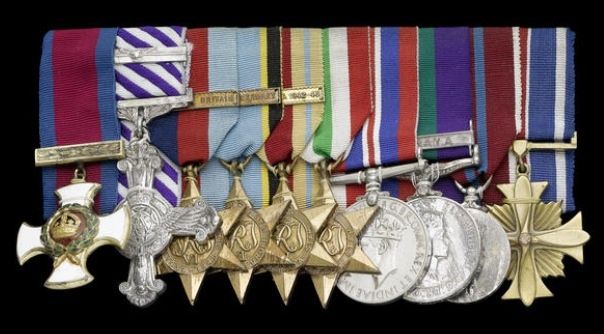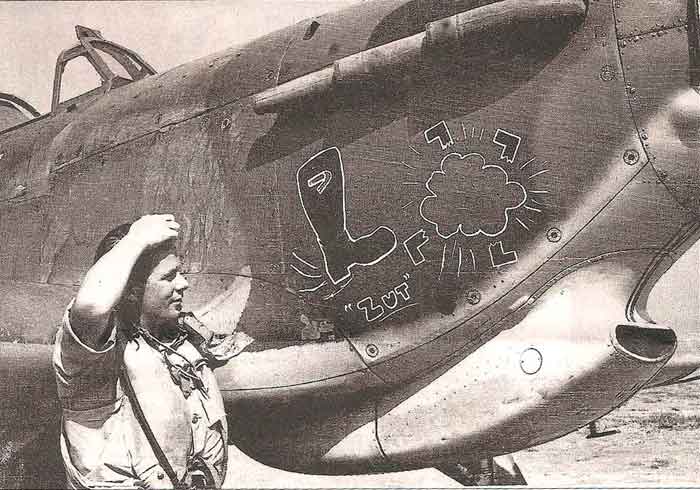A group of medals awarded to an outstanding WWII RAF pilot, Squadron Leader Billy Drake, heads the sale of military medals at Bonhams on March 12th in Knightsbridge.

Image Credit : Wikipedia Wing Commander Drake 1943
The US Distinguished Flying Cross awarded to him is partly visible, pinned to Drake's chest in the lower right corner of the above picture and at the end of the medal group below.

Image Credit : Bonhams
Originally Posted by Bonhams : Julian Roup
A group of medals awarded to an outstanding WWII RAF pilot, Squadron Leader Billy Drake, heads the sale of military medals at Bonhams on March 12th in Knightsbridge.
The most valuable group of medals in the sale - a Second World War D.S.O. and D.F.C. and bar group - awarded to Squadron Leader Billy Drake of the Royal Air Force is estimated to sell for £30,000-40,000.
Billy Drake was born in London on the 20th December 1917 to an English father and Australian mother. He was educated in Switzerland after several schools in England failed to cope with his lively temperament. On seeing an advertisement in the Aeroplane he joined the Royal Air Force, just before his 18th birthday, on a short service commission in July 1936. He was posted to 6 FTS, Netheravon on September 19 and with training completed joined No 1 Squadron at Tangmere on the 22nd May 1937, flying the Fury biplane fighter. In late 1938 the squadron received Hurricanes.
He went to France with No.1 Squadron in September 1939 which was posted to Neuville-sur-Ornain, near Reims. From here over the next few months patrols were taken over the coastal ports as ships carrying the British Expeditionary Force to the continent sailed across the Channel. After initial skirmishes with the Luftwaffe, Drake and his colleagues saw little action during the cold months of the "Phoney War".
But despite this slow start by October 1942 he had destroyed 17 aircraft in the air with two others shared, a total exceeded in North Africa only by one other pilot, the Australian born Group Captain Clive "Killer" Caldwell.
In January 1943 he was promoted to Wing Commander and posted to HQ RAF Cairo. He then took command of the Spitfire Wing in Malta in June 1943, and provided escort to USAAF bombers attacking Sicily, before returning to the UK he was credited with another six enemy aircraft destroyed. He received his American Distinguished Flying Cross in October 1943.
He was appointed Wing Leader 20 Wing flying Typhoons, in late November 1943, and attacked the German V-1 sites in the Pas-de-Calais. With his experience of fighter and ground tactics, he was sent to instruct at the RAF Fighter Leaders' School. Despite being in a training appointment, he frequently absconded for a day to take part in attacks against targets in France. His operational career came to an end in August 1944 where he was sent to The USA on special duties. On his return to the UK he was made Deputy Commander at Biggin Hill and later went to HQ SHAEF to serve in the Operations Room. He took part in the 1945 Battle of Britain flypast.
He was known for wearing a cravat in the colors of English Epsom Derby winner Hyperion, later recalled, "By God, we had a good time. That's not to say we behaved the way Hollywood likes to portray Battle of Britain pilots. Of course, there were a few randy ruffians who would chase any girl. But generally we all had girlfriends, and we didn't use the war as an excuse to sleep with them. We were gentlemen".
After the war he served in operational headquarters, first in Japan and then Singapore. In 1949 he was posted to the Fighter Leaders' School as a senior instructor, an appointment much to his liking and where he converted to jets. This was followed by his appointment as Wing Commander at Linton-on-Ouse near York, where he commanded three Meteor fighter squadrons. In 1956 Drake became the Controller of Fighter Command's Eastern Sector. But he still found time to persuade colleagues to allow him to fly their fighters two or three times a month. Two years later he left to be the Air attache in Switzerland spending the next three years in the country, a period he enjoyed greatly. He returned to the UK in 1962 and took command of the RAF's fighter training base at Chivenor in Devon, where he flew the Hawker Hunter. As a dedicated fighter pilot who had little interest in administration and staff work, he recognized that his flying days would soon be over. He therefore decided to retire from the Royal Air Force on the 1st July 1963, retaining the rank of Group Captain. He lived for 20 years in the Algarve where he owned Billy's Bar.
Billy Drake died at Teignmouth on the 28th August 2011, aged 93.
Bonhams Press Release
A more comprehensive personal history ...

Image Credit : RAF Jever Org : 112 Squadron Billy Drake
He was apparently a direct descendant of Sir Francis Drake.
Daily Telegraph Obituary August 2011
Coff.